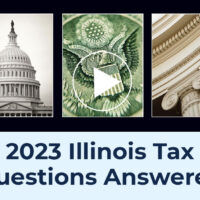
Among the many unusual things that happened during the COVID-19 pandemic, perhaps the most unusual was states rebating tax money to their citizens. As described in IRS notice IR-2023-23, 21 states made payments to their citizens during 2022.
IRS Describes Rebates As General Welfare and Disaster Relief
For most states, the IRS’s guidance describes these payments as relating to “general welfare and disaster relief,” adding that because filing season had already started, it wanted to bring clarity to the issue of whether these payments were subject to federal tax. Described in these terms, the payments from states would not be subject to tax, according to this February 10 notice.
It applied this logic to the following 17 states: Illinois, California, Colorado, Connecticut, Delaware, Florida, Hawaii, Idaho, Indiana, Maine, New Jersey, New Mexico, New York, Oregon, Pennsylvania, Rhode Island, and Alaska. The announcement noted that Alaska presented a special case, as the payment of the state’s permanent fund dividends would still be taxable, as well as compensation paid to workers.
The language in the notice states that the IRS will not “challenge the taxability” of payments “related to general welfare and disaster relief.” It states explicitly that residents of the 17 states listed above need not include any payments related to general welfare and disaster relief, but with a caveat for Illinois and New York discussed later.
The IRS then mentions that residents of Georgia, Massachusetts, South Carolina, and Virginia may be able to exclude their rebates from gross income based on the tax benefit rule.
Tax Benefit Rule Provision
The tax benefit rule provides that no payment received as a recovery for a prior year’s payment need be included in a taxpayer’s gross revenue if it did not reduce their tax in the previous year (IRC §111(a)). This is likely the case for most of these taxpayers, given the prevalent usage of the standard deduction and that $10,000 cap on deductible state and local tax (SALT) payments. Thus, a taxpayer who itemized in the year of the original tax deduction would not have to include their 2022 refund in taxable income if their total SALT payments exceeded the $10,000 cap by more than the refund. Seen another way, even if they itemized their deductions in a prior year, residents who paid significant SALT should not include their 2022 tax rebates in taxable income.
On the other hand, if their state and local taxes were less than the SALT cap and they itemized their deductions, the rebate might be taxable. There are some states with relatively low taxes in which this might be the case.
An Example Illustrates Complexities That Could Arise
To illustrate the complexity of this, consider two retired friends, Albert and Bernard, living only a few miles apart, but with a state boundary between them. Each receives a $300 state refund from their state. Albert pays $12,000 every year in property taxes in his state, but Bernard pays only $3,500 in property taxes, and his deduction for sales tax is $1,000. Both Albert and Bernard have enough other itemized deductions from their medical expenses, mortgage interest, and charitable contributions that neither uses the standard deduction.
In Albert’s case, the tax refund would have reduced his $12,000 property tax deduction to $11,700 ($12,000 – $300). Because he was only able to deduct $10,000 of state and local taxes, the rebate received does not affect his taxable income. The sales tax deduction does not come into play here.
But it’s a different story for his friend Bernard, whose state and local property tax deduction wasn’t affected by the $10,000 cap. In fact, his $4,500 SALT ($3,500 property tax + $1,000 sales tax) would have been reduced to $4,200 ($4,500 – $300), probably reducing his federal tax bill by $66 if he were in the 22% tax bracket. Thus, Bernard should include his $300 tax rebate in his gross income if he lives in a state that did not condition the rebate on general welfare and disaster relief.
Treatment for Illinois Taxpayers
The IRS News Release indicates that “people in the following states do not need to report these state payments on their 2022 tax return” and included Illinois in the list. However, a footnote at the bottom of the Notice’s second page qualifies this treatment as follows, and here’s where the caveat for Illinois and New York come into play.
Illinois and New York issued multiple payments and in each case one of the payments was a refund of taxes, which should be treated as noted above … [emphasis added]
Presumably, this reference points to citations of the tax benefit rule. Although the Illinois legislation that provided for the state rebates has been presented on the Illinois Department of Revenue’s website as the Illinois Family Relief Plan, the legislation itself refers to a “Residential real estate tax rebate” in §40-10 of Illinois Public Act 102-0700, which amends the Illinois income tax act by adding the following two sections
- 208.5 — Residential real estate tax rebate
- 212.1 — Individual income tax rebates
Neither section cites the need for general welfare and disaster relief in its language.
Regardless of this Act, taxpayers need not include the 2022 tax rebates in their income if they have used the standard deduction in past years, as the original SALT payment produced no tax benefit. The taxpayers choosing to itemize their tax deductions also probably do not need to worry about including the tax rebates in their income, provided their SALT payments that year exceeded $10,000.
It should be noted, though, that the situation is less clear for taxpayers who itemized in past years but had total tax deductions less than the $10,000 tax cap. In this case some analysis is required to see if they actually would have reduced their 2021 tax bill had the rebate arrived a year earlier. Although in many cases they received no federal tax benefit from the SALT payments, in some cases a federal tax benefit did arise, thereby requiring inclusion of the 2022 rebate in last year’s gross income.
What Should I Do for My Illinois Clients?
This points to the benefits of using the tax benefit rule to determine whether the state tax rebate someone received a few months ago should appear on their 2022 tax return. There is some question about whether Illinois taxpayers can take advantage of the “general welfare and disaster relief” principle, but if not, in most cases the tax benefit rule will indicate the taxpayer can exclude the rebate from gross income.
By John W. Richmann, EA, MBA
Tax Materials Specialist, U of I Tax School

Sources
IRC §§111(a), 139E, and 164(b)(6).
IRS Notice 2023-23
State Payments, Feb. 10, 2023. IRS. [www.irs.gov/newsroom/state-payments] Accessed on Feb. 13, 2023.
Tribal General Welfare Exclusion Act of 2014, PL 113-168.
Illinois Public Act 102-0700, §40-10. [www.ilga.gov/legislation/publicacts/102/PDF/102-0700.pdf#page=129] Accessed on Feb. 13, 2023.
2022 State of Illinois Tax Rebates. Illinois Department of Revenue. [tax.illinois.gov/programs/rebates.html] Accessed on Feb. 13, 2023.
Rev. Rul. 63-136, 1963-2 CB 19.
Rev. Rul. 74-413, 74-2 CB 333.
IRS Pub. 17, Tax Guide for Individuals, p. 69 (2022).



